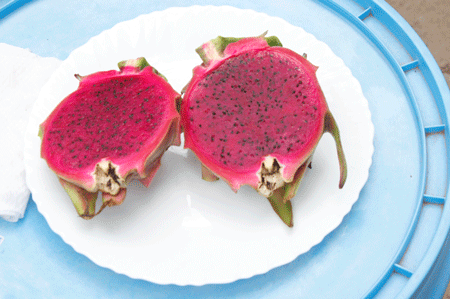
The growing appetite for dragon fruit among Kenyan farmers and consumers
A burgeoning health-conscious middle and upper class and the insatiable appetite by the export market is driving the uptake and farming of dragon fruit also known as Pitaya among farmers in Kenya with a kilo of the fruit costing up to Ksh 800 in upmarket outlets. The fruit weighs between 600 grammes and 1.2 kilograms
The latest horticultural sensation attracts a cocktail of uses from making beverages, salads, cake toppings, processed into pulp, fruit bars, yoghurt among other uses.
Dragon fruit is a low-calorie fruit that is high in fiber and contains a good number of vitamins and minerals.It has high water content and is a good source of iron, magnesium, vitamin B, phosphorus, protein, calcium, and fiber. The fruit’s edible seeds are also nutritious and have been proved to lower the risk of cardiovascular disorders, improve digestion, relieves arthritis, reduces body fat, acne, slows ageing, improves eyesight and boosts immunity.
It is a hit with farmers due to the fact that it is able to withstand harsh climatic and growing conditions. It also doesn’t require a lot of tending. Farmers are able to harvest it two months after planting. The fruit also provides environmental benefits such as low carbon footprint and uses few liters of water to produce.
One farmer who is reaping big from dragon fruit is Peter Murimi. Murimi has been able to consolidate clients through social media. He propagates vines which retails Ksh 500 at his farm. He has joined various online dragon fruit farmers’ groups to get more experience regarding the fruit; growing techniques, pruning techniques and basically what is required to take care of the plant.
In October 2020, Murimi with two other dragon fruit farmers in Kenya; Antony Mugambi, and Jennifer George formed a Facebook group account ‘Dragon Fruit Farmers Network Kenya’ with the aim of educating Kenyan farmers about dragon fruit farming and the health benefits of the fruit. Through the group, they have been able to tap in veterans who have been growing the fruit from other countries.
Besides the Facebook group, Murimi offers free trainings on the cultivation of the fruit. He encourages people to grow the fruit not only for wealth creation but also for their health purposes. “For my case my family and I are the first consumers of the fruit because we are health conscious. Dragon fruit a day keeps the doctor away,” he says.
Last year, former Environment and Forestry Cabinet Secretary Keriako Tobiko while meeting a section of Dragon Fruit Farmers Network Kenya said that research institutions and other government agencies were committed to doing more research to establish the environmental benefits of the plant which he said had prospective to provide new livelihoods especially for communities in ASAL areas. The then CS further said that accurate information was important in allowing farmers to take up farming of the fruit given its economic, environmental and health benefits.

According to nutritionist Stella Wanjala, the demand being experienced in Kenya for the fruit is due to the realization of its health benefits as consumers who are keen on their wellbeing explore various options of staying healthy. “The fruit that was traditionally not a hit and was predominantly imported in the country is attracting a new set of consumers across the country. This, as these health-conscious consumers explore healthy options at a time when lifestyle diseases are at an all time high. They are willing to spend a fortune on what promises them health benefits. The dragon fruit is in that league. In the end it is a good thing for farmers as it now creates a new farming revolution,” she said.
The demand for dragon fruit in the world is currently growing at about 4 per cent every year with the trend expected to continue. Key Kenyan export markets for the high value fruit include China, France, USA, Germany, Malaysia, Netherlands and Belgium among others.
According to a report by global research firm Mordor Intelligence, the dragon fruit market is growing at a robust rate, owing to the increasing demand for fresh dragon fruit. Additionally, the demand for exotic tropical fruit is on the rise in recent years due to various health benefits that they offer and an overall increase in disposable income of the consumers, especially in developing nations. In Europe, although the dragon fruit is relatively new and is not widely advertised, still the market is very promising and attracting more and more consumers.
“The European market is the world’s leading importer of fresh fruits and vegetables, and quite open to new products. Therefore, although the dragon fruit is a relatively new and not widely advertised, the price is high, but still very promising and attracting more and more consumers on the continent. If it is possible to reduce the cost and further promote the nutritional value of dragon fruit, it will certainly reach most of the population in European countries,” read another report.
Vietnam is currently the largest dragon fruit supplier in the world, accounting for the highest share in Asia, Europe and sometimes in the United States. Thailand and Israel are the second and third largest suppliers in the European market. In the United States, Mexico and Central and South America are the biggest competitors of Asian dragon fruit suppliers due to geographical advantages.
Asia is the largest and most easily consumed dragon fruit market, especially in the Chinese community, due to the belief in the good fortune brought by the dragon fruit’s name, shapes, and colors. China is the largest consumer of dragon fruit in Asia and is also the largest in the world today.



